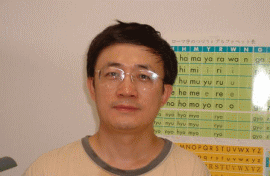
@@@
@
 |
@
@I am from Institute of Geology and Geophysics, Chinese Academy of Sciences.
I graduated from the department of geology, Peking University. After one
year of training in French in the University of Languages of Beijing, I
went to France for my master and PhD degrees in the National Superior School
of Geology and Mining, National Polytechnic Institute of Lorraine and Research
Center of Geochemistry and Petrology, CNRS. For my master degree, I studied
natural fluid inclusions trapped in quartz during the formation of ore
deposits. When I just started my PhD degree, I was very lucky to meet Dr.
John Frantz from Geophysical Laboratory, Carnegie Institution of Washington,
USA, who was just starting to do his sabbatical year in France. With him,
we started a long-term and very successful cooperation. We used synthetic
fluid inclusions to study the immiscibility and isochors of many different
fluid systems.
@After my PhD, I went to Geophysical Laboratory to do my postdoctor. Again
with Dr. John Frantz, we invented a method to load gas mixtures of desired
composition into capsules. This makes it possible to study systems such
as H2O-CO2-CH4-N2. Before the work, experiments studying gas mixtures used
the decomposition of organic materials, which makes the control of gas
compositions difficult.
@After five years in foreign countries, I went back to China in 1989 and started to work in the Institute of Geology, Chinese Academy of Sciences. During my first years in the institute, I became a pure geologist and did some hard field works. I remember that with my colleagues, we lived in a peasant's house, and squeezed in one bed with the peasant's son and with everybody allocated 60 cm of the bed. There was nothing else to eat beyond potato and leek. So it's potato and leek for breakfast, lunch, and dinner. This was the best they could do, and so we just lived as they did. I studied the volcanic rocks and the enclosed xenoliths in northeast China. The volcanic rocks are very potassium rich and believed to have a deep origin. The xenoliths, samples of the upper mantle, have very diverse types. I also studied the high-pressure granulite in north China craton. One typical character of the granulite is the retrograde ring around garnet. At the same time, I did some experimental work on the equilibrium between rocks and immiscible fluid.
@In 1994, I obtained an award from Chinese Academy of Sciences, which
gave me a chance to go abroad. I picked up Geophysical Laboratory again
and stayed there for nine months. I used piston cylinder technique to study
the composition of water in equilibrium with enstatite and forsterite,
important for considering mantle metasomatism above subduction zone. I
discovered that silica dissolved in water exists as polymers. This is important
as previous thermodynamic calculations on fluid-rock interactions have
always assumed that silica exist in water as monomer. The assumption makes
the calculation relatively easy, but Nature certainly doesn't like to be
that simple.
@After returning back to China in 1996 and seeing the fast growth of computational
power, I started to do molecular dynamics simulations. Together with my
students, we studied the viscosity of water, silicate melt, and outer core.
One of my student is now studying the nucleation mechanism of clathrate.
@Impressed by the large proportions of scientific contributions from the
center, I feel very honored to be invited here. Together with professor
Zhao Dapeng, we're studying elasticity of some minerals. The result, when
combined with his seismic tomography, will certainly help us understand
better the deep Earth.

©@Back
@ @@ Yigang Zhang
@ iOl€υiqυjj
